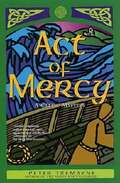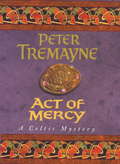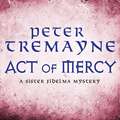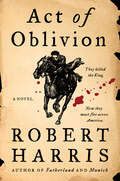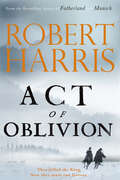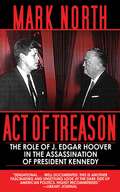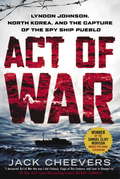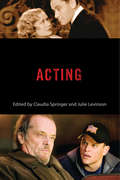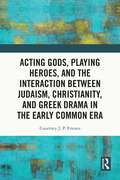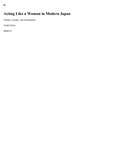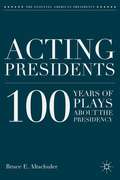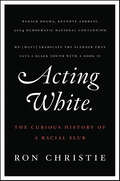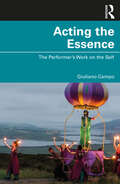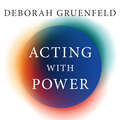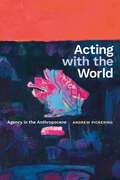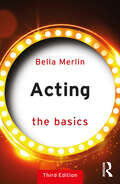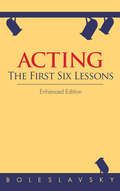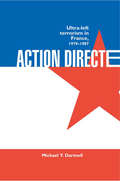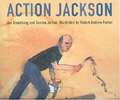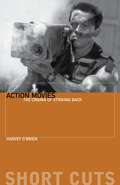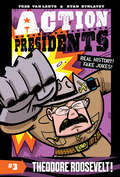- Table View
- List View
Act of Mercy: A Mystery of Ancient Ireland (Sister Fidelma Mystery #8)
by Peter TremayneIn the late autumn of 666 A.D., Fidelma of Cashel - an advocate of the Brehon Courts, sister to the King of Cashel, and religieuse of the Celtic Church - is at a crossroads. Needing to reflect upon her commitment to the religious life and her relationship to the Saxon monk Eadulf, she leaves Eadulf behind and joins a small band sailing from Ireland on a pilgrimage to the Shrine of St. James in modern-day Spain. Her first surprise on-board is the appearance of Cian, her first love, a man who had deserted her ten years ago, and who stirs up memories she'd rather forget. As if this wasn't complication enough, on the first night out the ship is tossed by a turbulent sea and a pilgrim disappears, apparently washed overboard. But the appearance of a blood-stained robe raises the possibility of murder and death continues to dog the tiny band of pilgrims trapped within the close confines of the ship. Battling against the antagonism of her fellow pilgrims, Fidelma is determined to solve this most perplexing of puzzles before the ship reaches the shrine and the killer, if there is one, disappears forever.
Act of Mercy: A page-turning Celtic mystery filled with chilling twists (Sister Fidelma)
by Peter TremayneSuper sleuth Sister Fidelma returns in the eighth historical mystery by Peter Tremayne, acclaimed author of THE MONK WHO VANISHED, VALLEY OF THE SHADOW and many more.PRAISE FOR ACT OF MERCY: 'Wonderfully evocative' The Times When Sister Fidelma sets out on a pilgrimage in the autumn of AD 666, her main preoccupation is to reflect on her commitment to the religious life and her relationship with the Saxon monk, Eadulf, whom she has left behind. Complications arise during the first night on the ship when one of the pilgrims is apparently washed overboard. The discovery of a blood-stained robe raises the question of murder and Fidelma finds herself having to focus all her abilities on solving the mystery. Death dogs the tiny band of pilgrims in the close confines of the ship, but is not until the Holy Shrine is almost reached that the amazing truth is uncovered... What readers are saying about ACT OF MERCY:'I never tire of reading about the escapades of this very self-opinionated young woman and her interactions with some very strange characters! Another great read!''So many twists I could not put it down! Pilgrims and pirates - Fidelma has trouble finding the truth''An intriguing glimpse of Fidelma's interior life and past'
Act of Mercy: A page-turning Celtic mystery filled with chilling twists (Sister Fidelma)
by Peter TremayneSuper sleuth Sister Fidelma returns in the eighth historical mystery by Peter Tremayne, acclaimed author of THE MONK WHO VANISHED, VALLEY OF THE SHADOW and many more.When Sister Fidelma sets out on a pilgrimage in the autumn of AD 666, her main preoccupation is to reflect on her commitment to the religious life and her relationship with the Saxon monk, Eadulf, whom she has left behind. Complications arise during the first night on the ship when one of the pilgrims is apparently washed overboard. The discovery of a blood-stained robe raises the question of murder and Fidelma finds herself having to focus all her abilities on solving the mystery. Death dogs the tiny band of pilgrims in the close confines of the ship, but is not until the Holy Shrine is almost reached that the amazing truth is uncovered... (P) 2015 Audible, Inc.
Act of Oblivion: A Novel
by Robert HarrisFrom the bestselling author of Fatherland, The Ghostwriter, Munich, and Conclave comes this spellbinding historical novel that brilliantly imagines one of the greatest manhunts in history: the search for two Englishmen involved in the killing of King Charles I and the implacable foe on their trail—an epic journey into the wilds of seventeeth-century New England, and a chase like no other.'From what is it they flee?'He took a while to reply. By the time he spoke the men had gone inside. He said quietly, “They killed the King.”1660 England. General Edward Whalley and his son-in law Colonel William Goffe board a ship bound for the New World. They are on the run, wanted for the murder of King Charles I—a brazen execution that marked the culmination of the English Civil War, in which parliamentarians successfully battled royalists for control.But now, ten years after Charles’ beheading, the royalists have returned to power. Under the provisions of the Act of Oblivion, the fifty-nine men who signed the king’s death warrant and participated in his execution have been found guilty in absentia of high treason. Some of the Roundheads, including Oliver Cromwell, are already dead. Others have been captured, hung, drawn, and quartered. A few are imprisoned for life. But two have escaped to America by boat.In London, Richard Nayler, secretary of the regicide committee of the Privy Council, is charged with bringing the traitors to justice and he will stop at nothing to find them. A substantial bounty hangs over their heads for their capture—dead or alive. . . .Robert Harris’s first historical novel set predominantly in America, Act of Oblivion is a novel with an urgent narrative, remarkable characters, and an epic true story to tell of religion, vengeance, and power—and the costs to those who wield it.
Act of Oblivion: A Novel
by Robert HarrisINTERNATIONAL BESTSELLERFrom the bestselling author of Fatherland, The Ghostwriter, Munich, and Conclave comes this spellbinding historical novel that brilliantly imagines one of the greatest manhunts in history: the search for two Englishmen, charged in the killing of King Charles I, by the implacable foe on their trail—an epic journey into the wilds of seventeenth-century New England, and a chase like no other."From what is it they run?"He took a while to reply. By the time he spoke the men had gone inside. He said quietly, &“They killed the King.&”1660. General Edward Whalley and his son-in-law Colonel William Goffe board a ship in London bound for the New World and an uncertain future in exile. They are wanted for the 1649 murder of King Charles I – a brazen execution that marked the culmination of the English Civil War, in which parliamentarians successfully battled royalists for control. But ten years after Charles&’ beheading, the royalists returned to power. Under the provisions of the Act of Oblivion, the fifty-nine men who signed the king&’s death warrant have been found guilty in absentia of high treason. Some parliamentarians, including Oliver Cromwell, are dead; others have been captured, hung, drawn, and quartered. A few are imprisoned for life. But Whalley and Goffe escaped to New England. In London, Richard Nayler, secretary of the regicide committee of the Privy Council, is charged with bringing the traitors back home to justice and will stop at nothing to find them. A substantial bounty hangs over their heads for their capture – dead or alive. Encompassing a period of tremendous upheaval in English history the novel brings alive pivotal moments including the Black Death and the Great Fire of London as Nayler closes in on the exiles. Act of Oblivion is an epic story of religion, vengeance, and of power – and the costs to those who wield it.
Act of Treason: The Role of J. Edgar Hoover in the Assassination of President Kennedy
by Mark NorthIn this meticulously researched classic of the JFK conspiracy genre that Library Journal calls "sensational," Mark North argues convincingly that President John F. Kennedy died as the result of a plot masterminded by Louisiana Mafia chieftain Carlos Marcello-and, more importantly, that FBI chief J. Edgar Hoover learned early on about the plan but did nothing to stop it. Hoover warned no one-not the Dallas police, not the Secret Service. His motives, North suggests, stemmed from a fervent hatred of Kennedy and fear that the President would eventually fire him. He is documented as a close confidant of Vice President Lyndon Johnson-a man Hoover "controlled" due to blackmail and scandals. Hoover's day-to-day running of the FBI, his strange personality, and his backroom dealings are brought to life using an extensive collection of press clippings, government documents, and other original sources. Act of Treason is a must-read for any citizen who believes the Warren Commission failed miserably in its attempt to solve one of modern America's most pressing mysteries: Who killed JFK?
Act of War
by Jack CheeversA powerful account of the infamous 1968 USS Pueblo incident, in which Captain Pete Bucher and his crew were captured by the North Koreans in international waters, imprisoned and tortured for 11 months, only to return to fight an embarrassed Navy establishment that wanted to court-martial Bucher for the Navy's own failures.
Act of War
by Jack CheeversIn 1968, a small, dilapidated American spy ship set out on a dangerous mission: to pinpoint military radar stations along the coast of North Korea. Packed with advanced electronic-surveillance equipment and classified intelligence documents, the USS Pueblo was poorly armed and lacked backup by air or sea. Its crew, led by a charismatic, hard-drinking ex-submarine officer named Pete Bucher, was made up mostly of untested sailors in their teens and twenties. On a frigid January morning while eavesdropping near the port of Wonsan, the Pueblo was challenged by a North Korean gunboat. When Bucher tried to escape, his ship was quickly surrounded by more patrol boats, shelled and machine-gunned, and forced to surrender. One American was killed and ten wounded, and Bucher and his young crew were taken prisoner by one of the world's most aggressive and erratic totalitarian regimes. Less than forty-eight hours before the Pueblo's capture, North Korean commandos had nearly succeeded in assassinating South Korea's president in downtown Seoul. Together, the two explosive incidents pushed Cold War tensions toward a flashpoint as both North and South Korea girded for war--with fifty thousand American soldiers caught between them. President Lyndon Johnson rushed U.S. combat ships and aircraft to reinforce South Korea, while secretly trying to negotiate a peaceful solution to the crisis. Act of War tells the riveting saga of Bucher and his men as they struggled to survive merciless torture and horrendous living conditions in North Korean prisons. Based on extensive interviews and numerous government documents released through the Freedom of Information Act, this book also reveals new details of Johnson's high-risk gambit to prevent war from erupting on the Korean peninsula while his negotiators desperately tried to save the sailors from possible execution. A dramatic tale of human endurance against the backdrop of an international diplomatic poker game, Act of War offers lessons on the perils of covert intelligence operations as America finds itself confronting a host of twenty-first-century enemies.
Acting
by Cynthia Baron David Sterritt Claudia Springer Arthur Nolletti Jr. Donna Peberdy Julie Levinson Victoria DuckettScreen performances entertain and delight us but we rarely stop to consider actors' reliance on their craft to create memorable characters. Although film acting may appear effortless, a host of techniques, artistic conventions, and social factors shape the construction of each role. The chapters in Acting provide a fascinating, in-depth look at the history of film acting, from its inception in 1895 when spectators thrilled at the sight of vaudeville performers, Wild West stars, and athletes captured in motion, to the present when audiences marvel at the seamless blend of human actors with CGI. Experts in the field take readers behind the silver screen to learn about the craft of film acting in six eras: the silent screen (1895-1928), classical Hollywood (1928-1946), postwar Hollywood (1947-1967), the auteur renaissance (1968-1980), the New Hollywood (1981-1999), and the modern entertainment marketplace (2000-present). The contributors pay special attention to definitive performances by notable film stars, including Lillian Gish, Dick Powell, Ginger Rogers, Beulah Bondi, Marilyn Monroe, Marlon Brando, Jack Nicholson, Robert De Niro, Nicholas Cage, Denzel Washington, and Andy Serkis. In six original essays, the contributors to this volume illuminate the dynamic role of acting in the creation and evolving practices of the American film industry. Acting is a volume in the Behind the Silver Screen series--other titles in the series include Animation; Art Direction and Production Design; Cinematography; Costume, Makeup, and Hair; Directing; Editing and Special/Visual Effects; Producing; Screenwriting; and Sound.
Acting Gods, Playing Heroes, and the Interaction between Judaism, Christianity, and Greek Drama in the Early Common Era
by Courtney J. FriesenWhile many ancient Jewish and Christian leaders voiced opposition to Greek and Roman theater, this volume demonstrates that by the time the public performance of classical drama ceased at the end of antiquity the ideals of Jews and Christians had already been shaped by it in profound and lasting ways. Readers are invited to explore how gods and heroes famous from Greek drama animated the imaginations of ancient individuals and communities as they articulated and reinvented their religious visions for a new era. In this study, Friesen demonstrates that Greek theater’s influence is evident within Jewish and Christian intellectual formulations, narrative constructions, and practices of ritual and liturgy. Through a series of interrelated case studies, the book examines how particular plays, through texts and performances, scenes, images, and heroic personae, retained appeal for Jewish and Christian communities across antiquity. The volume takes an interdisciplinary approach involving classical, Jewish, and Christian studies, and brings together these separate avenues of scholarship to produce fresh insights and a reevaluation of theatrical drama in relation to ancient Judaism and Christianity. Acting Gods, Playing Heroes, and the Interaction between Judaism, Christianity, and Greek Drama in the Early Common Era allows students and scholars of the diverse and evolving religious landscapes of antiquity to gain fresh perspectives on the interplay between the gods and heroes—both human and divine—of Greeks and Romans, Jews and Christians as they were staged in drama and depicted in literature.
Acting Like a Women in Modern Japan: Theater, Gender, and Nationalism
by Ayako KanoWeaving together careful readings of plays and reviews, memoirs and interviews, biographies and critical essays, Acting Like a Woman in Modern Japan traces the emergence of the first generation of modern actresses in Japan, a nation in which male actors had long dominated the public stage. What emerges is a colorful and complex picture of modern Japanese gender, theater, and nationhood. Using the lives and careers of two dominant actresses from the Meiji era, Kano reveals the fantasies, fears, and impact that women on stage created in Japan as it entered the twentieth century.
Acting Naturally: The Magic in Great Performances
by David ThomsonFrom the celebrated film critic and author of The New Biographical Dictionary of Film, a fascinating look at some of the cinema&’s finest actors and how they approach their craft"Open to any page and you&’ll become enthralled by the...tales of forgotten film lore, childhood memories, sexy gossip.&”—Philip Kaufman, directorMeryl Streep, Marlon Brando, Anthony Hopkins, Carey Mulligan. When we watch these remarkable actors in a performance, we see only Sophie, Stanley Kowalski, Hannibal Lecter, or Cassie from Promising Young Woman. How are they able to transform our world in this way? How and why do they do what they do?In Acting Naturally, David Thomson sheds light on the actors who have shaped the film industry. He shrewdly analyzes these stars—among them, James Dean, Nicole Kidman, Denzel Washington, Louise Brooks, Riz Ahmed, Sir Laurence Olivier, Viola Davis, and Jean Seberg—revealing how a sly smile, an extra-long pause, even a small gesture of the hand can draw in an audience. And he takes us behind the scenes to examine casting and all the other moments leading up to &“Action!&”Through intimate anecdote, humor, and the insight born of a lifetime watching and analyzing film, Thomson explores the real reasons why we go to the movies and looks at how they influence our lives. This book is not only necessary reading for an insider&’s view of the industry but also a surprising investigation of the relationship between acting and living.
Acting Presidents
by Bruce E. AltschulerThis book seeks to fill a major gap in the literature about fictional representations of presidents by studying more than 40 plays, written since 1900, which have had prominent productions on or off-Broadway or in another major city.
Acting White: The Curious History of a Racial Slur
by Ron ChristieIn the tradition of Randall Kennedy's Nigger and Shelby Steele's The Content of Our Character, Acting White demonstrates how the charge that any African-American who is successful, well mannered, or well educated is "acting white," is a slur that continues to haunt blacks. Ron Christie traces the complex history of the phrase, from Uncle Tom's Cabin to the tensions between Martin Luther King, Jr., and Malcolm X to Bill Cosby's controversial NAACP speech in 2004. The author also writes candidly of being challenged by black students for his "acting white," and also of being labeled a race traitor in Congress by daring to be Republican. This lucid chronicle reveals how this prevalent put-down sets back much of the hard-earned progress for all blacks in American society. Deftly argued and determinedly controversial, this book is certain to spur thoughtful discussion for years to come.
Acting the Essence: The Performer's Work on the Self
by Giuliano CampoActing the Essence examines the theory, practice, and history of the art of the performer from the perspective of its inner nature as work on oneself, within, around, and beyond the pedagogy of the actor. Ref lecting primarily on the legacy of Jerzy Grotowski, this book is composed of a series of ref lections on the Stanislavskian lineage of practitioners and related authors, in an attempt to revive awareness of the original path traced by the Russian master and to refine certain ambiguities in contemporary training. In a new media age of image and sound, accompanied by a proliferation of new technologies and means to communicate, emphasised by the COVID-19 crisis, a classic question comes to be asked of us again: What is the essence and the principal objective of the work of the performer? Is performing art still necessary? While proposing a theoretical advancement of the discipline and an historical overview of the relevant practices, this book provides tools for a better understanding of the traditional function of the performer’s practice as work on the self, for its ecological renaissance through a conscient use of trance, attention, and altered states of consciousness. This book offers insight for students in drama, theatre, and performance courses studying acting and performance at university.
Acting with Power
by Deborah GruenfeldThis is a book designed to change the way we think about power in very fundamentals ways. Informed by twenty years of research on the psychology of power, as well as her own personal experiences, Acting with Power is both a prescription for anyone struggling with authority issues, but also social commentary on how we so often misinterpret power and in doing so, fail to live up to our own ideals. We watch people make naked power grabs and cringe, turning away from embracing power as something that is within the realm of the narcissistic. It feels incongruent with our values, with being a good person. What Gruenfeld argues is that in fact it is impossible to be a good person- one who is respected by others and ourselves- without getting comfortable with power. A good person does what's best for the group and sometimes that means standing up for others with less power, putting a bad actor in their place, or letting someone else be in charge so that the group can move forward. What's necessary, then, is becoming fluent in the language of power- easily capable of dominance and skilled at deference. In other words, responsive to the hierarchical circumstances,knowing one's status within the group and using that knowledge to earn power and increased status.
Acting with the World: Agency in the Anthropocene
by Andrew PickeringIn the Anthropocene our actions are coming home to roost. Global warming, species extinctions, and environmental disasters are the dark side of our mastery of nature. In Acting with the World, Andrew Pickering identifies a different pattern of being and doing that can evade this dark side, a pattern that he calls acting-with the world. In contrast to our usual practice of acting on the world, acting-with foregrounds nonhuman or more-than-human agency and aims to attune our practices to the propensities of nature. Pickering explores examples of acting-with from around the globe, including flood control on the Mississippi River, ecosystem restoration on the Colorado River, the Room for the River project and rewilding in the Netherlands, natural farming in Japan, Aboriginal fire techniques in Australia, and Amazonian shamanism. Pickering argues that acting-with intimately and gracefully plugs us into nature, undercuts the Anthropocene from below, and offers a constructive approach to addressing otherwise intractable wicked problems.
Acting: The Basics (The Basics)
by Bella MerlinActing: The Basics 3rd Edition is a dynamic response to recent societal and entertainment industry changes, focusing on inclusion, diversity and equity, and the actor's trajectory from training to rehearsal to performance on stage and screen, with hands-on tools and global perspectives. The book offers vital ways of building a practical acting toolkit, through breath, body, voice, emotions, imagination and spirit. We begin with a socio-cultural look at actor as magician, storyteller, healer and social changer. Throughout, there are insights from Black, Indigenous, First Nations, South/East Asian, intercultural and feminist practitioners, together with methods focusing on disability and accessibility, intimacy directives, mindfulness and intersectionality. Key 'canonical' figures still feature (e.g., Stanislavsky, Meisner, Brecht and Suzuki) with re-visioned perspective. Scattered throughout are post-COVID insights, plus expanded sections on screen acting (including self-tapes) and Shakespeare. This book is useful for beginner or expert, as it's always helpful getting back to basics. Because the author is both an actor and an actor trainer, the tools are steeped in user-friendly application. At the same time, transferable skills (e.g., dynamic listening and empathy) are shown as relevant to everyone. With a glossary of terms and useful online suggestions (including blogs, videos and podcasts), this is ideal for anyone learn anew about the practice and history of acting, or to take their acting and teaching into new terrain.
Acting: The First Six Lessons
by Richard BoleslavskyThe classic text on the craft of Method acting by the founder of The American Laboratory Theatre.After studying at the Moscow Art Theatre under Konstantin Stanislavski, Richard Boleslavsky became one of the most important acting teachers of his or any generation. Bringing Stanislavski&’s system to America in the 1920s and 30s, he influenced many of the titans of American drama, from his own students—including Lee Strasburg and Stella Adler—to Marlon Brando, Paul Newman, and many others.In Acting: The First Six Lessons, Boleslavsky presents his acting theory and technique in a series of accessible and engaging dialogues. Widely considered a must-have for any serious actor, Boleslavsky&’s work has long helped actors better understand their craft.
Action Directe: Ultra Left Terrorism in France 1979-1987
by Michael Y. DartnellIn defining Action Directe's mixture of millenarianism, workerism and nihilism, this study explains why the group turned to a strategy of murderous strikes and how a revolutionary political faction emerged in a stable western society.
Action Jackson
by Jan Greenberg Sandra JordanOne late spring morning the American artist Jackson Pollock began work on the canvas that would ultimately come to be known as Number 1, 1950 ("Lavender Mist"). Award-winning authors Jan Greenberg and Sandra Jordan use this moment as the departure point for a unique picture book about a great painter and the way in which he worked. Their lyrical text, drawn from Pollock's own comments and those made by members of his immediate circle, is perfectly complemented by vibrant watercolors by Robert Andrew Parker that honor his spirit of the artist without imitating his paintings. A photographic reproduction of the finished painting, a short biography, a bibliography, and a detailed list of notes and sources that are fascinating reading in their own right make this an authoritative as well as beautiful book for readers of all ages.<P><P> Winner of the Sibert Honor
Action Movies: The Cinema of Striking Back
by Harvey O'BrienAction Movies: The Cinema of Striking Back is a study of action cinema, exploring the ethics and aesthetics of the genre with reference to its relatively short history. It moves from seminal classics like Bullitt (1968) and Dirty Harry (1971) through epoch-defining films like Rambo: First Blood Part II (1985) and Die Hard (1988) to revisions, reboots, and renewals in films like Kill Bill Vol. 1 (2003), Taken (2008), and The Expendables (2010).
Action Movies: The Cinema of Striking Back
by Harvey O'BrienAction Movies: The Cinema of Striking Back is a study of action cinema, exploring the ethics and aesthetics of the genre with reference to its relatively short history. It moves from seminal classics like Bullitt (1968) and Dirty Harry (1971) through epoch-defining films like Rambo: First Blood Part II (1985) and Die Hard (1988) to revisions, reboots, and renewals in films like Kill Bill Vol. 1 (2003), Taken (2008), and The Expendables (2010). The action genre is a fusion of form and content: a cinema of action about action. It is a cinema of the will, configured as a decisive reaction to untenable circumstances. Action heroes take up arms against the sea of troubles that beset them, safe in the knowledge that if they don't do it, nobody will. Though this makes the action movie profoundly disturbing as an embodiment of moral ideology, its enduring appeal proves the appetite for assurance remains undiminished, even in the wake of 9/11.
Action Park: Fast Times, Wild Rides, and the Untold Story of America's Most Dangerous Amusement Park
by Jake Rossen Andy MulvihillThe outlandish, hilarious, terrifying, and almost impossible-to-believe story of the legendary, dangerous amusement park where millions were entertained and almost as many bruises were sustained, told through the eyes of the founder's sonOften called "Accident Park," "Class Action Park," or "Traction Park," Action Park was an American icon. Entertaining more than a million people a year in the 1980s, the New Jersey-based amusement playland placed no limits on danger or fun, a monument to the anything-goes spirit of the era that left guests in control of their own adventures--sometimes with tragic results. Though it closed its doors in 1996 after nearly twenty years, it has remained a subject of constant fascination ever since, an establishment completely anathema to our modern culture of rules and safety. Action Park is the first-ever unvarnished look at the history of this DIY Disneyland, as seen through the eyes of Andy Mulvihill, the son of the park's idiosyncratic founder, Gene Mulvihill. From his early days testing precarious rides to working his way up to chief lifeguard of the infamous Wave Pool to later helping run the whole park, Andy's story is equal parts hilarious and moving, chronicling the life and death of a uniquely American attraction, a wet and wild 1980s adolescence, and a son's struggle to understand his father's quixotic quest to become the Walt Disney of New Jersey. Packing in all of the excitement of a day at Action Park, this is destined to be one of the most unforgettable memoirs of the year.
Action Presidents #3: Theodore Roosevelt! (Action Presidents #3)
by Fred Van Lente“A delightful, educational spin on history—and plenty of jokes,” said School Library Journal. “Sheer joy,” praised Booklist in a starred review. Finalist for the 2019 Excellence in Graphic Literature Award in Middle Grade Nonfiction U.S. history comes to life like never before in this full-color graphic novel! We all know that Theodore Roosevelt protected the environment and was the cousin of President Franklin Roosevelt. But did you also know that he was the inspiration for the teddy bear, wrote adventure books, and once gave a speech with a gunshot wound in his chest? Wimpy Kid meets the Who Was... series in these hilarious new graphic novels—where the history is real and the jokes are fake—from New York Times bestselling comic book author Fred Van Lente and award-winning cartoonist Ryan Dunlavey. Historically accurate and highly entertaining, Action Presidents’ bold and hilarious comic-style illustration is perfect for curious minds, filled with timelines, maps, charts, and more, readers will keep learning until the last page.
